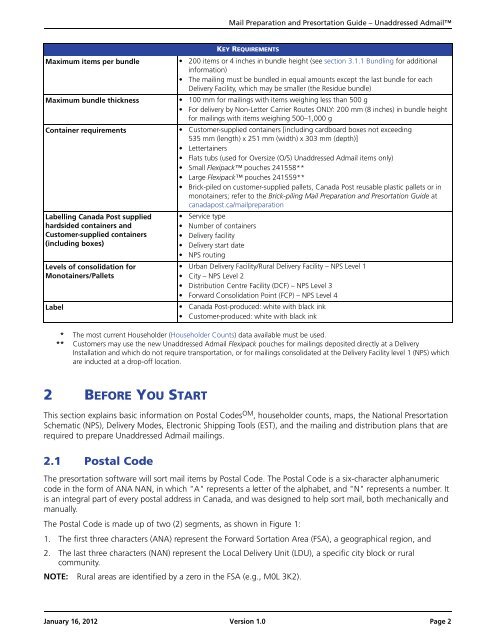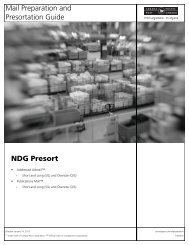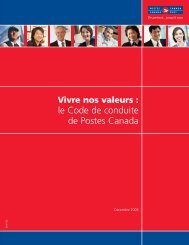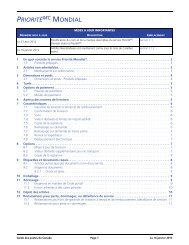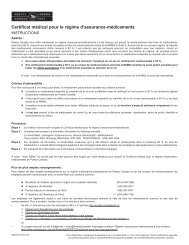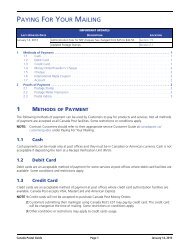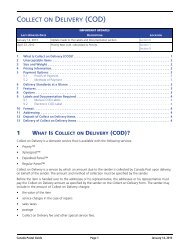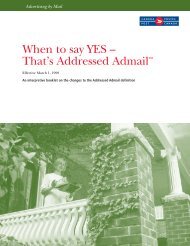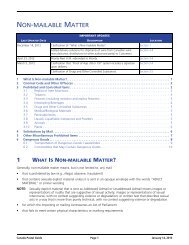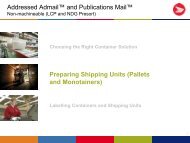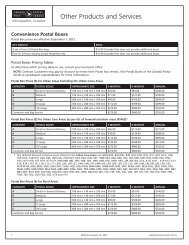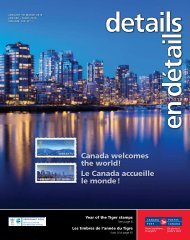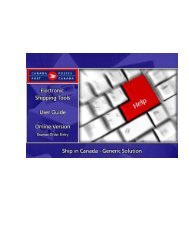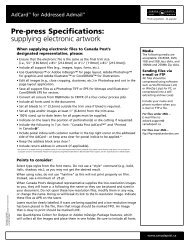Unaddressed Admail - Canada Post
Unaddressed Admail - Canada Post
Unaddressed Admail - Canada Post
Create successful ePaper yourself
Turn your PDF publications into a flip-book with our unique Google optimized e-Paper software.
Mail Preparation and Presortation Guide – <strong>Unaddressed</strong> <strong>Admail</strong><br />
Maximum items per bundle 200 items or 4 inches in bundle height (see section 3.1.1 Bundling for additional<br />
information)<br />
The mailing must be bundled in equal amounts except the last bundle for each<br />
Delivery Facility, which may be smaller (the Residue bundle)<br />
Maximum bundle thickness 100 mm for mailings with items weighing less than 500 g<br />
For delivery by Non-Letter Carrier Routes ONLY: 200 mm (8 inches) in bundle height<br />
for mailings with items weighing 500–1,000 g<br />
Container requirements Customer-supplied containers [including cardboard boxes not exceeding<br />
535 mm (length) x 251 mm (width) x 303 mm (depth)]<br />
Lettertainers<br />
Flats tubs (used for Oversize (O/S) <strong>Unaddressed</strong> <strong>Admail</strong> items only)<br />
Small Flexipack pouches 241558**<br />
Large Flexipack pouches 241559**<br />
Brick-piled on customer-supplied pallets, <strong>Canada</strong> <strong>Post</strong> reusable plastic pallets or in<br />
monotainers; refer to the Brick-piling Mail Preparation and Presortation Guide at<br />
canadapost.ca/mailpreparation<br />
Labelling <strong>Canada</strong> <strong>Post</strong> supplied<br />
hardsided containers and<br />
Customer-supplied containers<br />
(including boxes)<br />
Levels of consolidation for<br />
Monotainers/Pallets<br />
* The most current Householder (Householder Counts) data available must be used.<br />
** Customers may use the new <strong>Unaddressed</strong> <strong>Admail</strong> Flexipack pouches for mailings deposited directly at a Delivery<br />
Installation and which do not require transportation, or for mailings consolidated at the Delivery Facility level 1 (NPS) which<br />
are inducted at a drop-off location.<br />
2 BEFORE YOU START<br />
This section explains basic information on <strong>Post</strong>al Codes OM , householder counts, maps, the National Presortation<br />
Schematic (NPS), Delivery Modes, Electronic Shipping Tools (EST), and the mailing and distribution plans that are<br />
required to prepare <strong>Unaddressed</strong> <strong>Admail</strong> mailings.<br />
2.1 <strong>Post</strong>al Code<br />
KEY REQUIREMENTS<br />
Service type<br />
Number of containers<br />
Delivery facility<br />
Delivery start date<br />
NPS routing<br />
Urban Delivery Facility/Rural Delivery Facility – NPS Level 1<br />
City – NPS Level 2<br />
Distribution Centre Facility (DCF) – NPS Level 3<br />
Forward Consolidation Point (FCP) – NPS Level 4<br />
Label <strong>Canada</strong> <strong>Post</strong>-produced: white with black ink<br />
Customer-produced: white with black ink<br />
The presortation software will sort mail items by <strong>Post</strong>al Code. The <strong>Post</strong>al Code is a six-character alphanumeric<br />
code in the form of ANA NAN, in which "A" represents a letter of the alphabet, and "N" represents a number. It<br />
is an integral part of every postal address in <strong>Canada</strong>, and was designed to help sort mail, both mechanically and<br />
manually.<br />
The <strong>Post</strong>al Code is made up of two (2) segments, as shown in Figure 1:<br />
1. The first three characters (ANA) represent the Forward Sortation Area (FSA), a geographical region, and<br />
2. The last three characters (NAN) represent the Local Delivery Unit (LDU), a specific city block or rural<br />
community.<br />
NOTE: Rural areas are identified by a zero in the FSA (e.g., M0L 3K2).<br />
January 16, 2012 Version 1.0 Page 2


